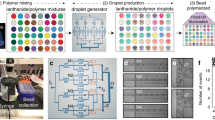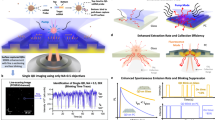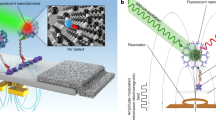Abstract
Multicolor optical coding for biological assays has been achieved by embedding different-sized quantum dots (zinc sulfide–capped cadmium selenide nanocrystals) into polymeric microbeads at precisely controlled ratios. Their novel optical properties (e.g., size-tunable emission and simultaneous excitation) render these highly luminescent quantum dots (QDs) ideal fluorophores for wavelength-and-intensity multiplexing. The use of 10 intensity levels and 6 colors could theoretically code one million nucleic acid or protein sequences. Imaging and spectroscopic measurements indicate that the QD-tagged beads are highly uniform and reproducible, yielding bead identification accuracies as high as 99.99% under favorable conditions. DNA hybridization studies demonstrate that the coding and target signals can be simultaneously read at the single-bead level. This spectral coding technology is expected to open new opportunities in gene expression studies, high-throughput screening, and medical diagnostics.
This is a preview of subscription content, access via your institution
Access options
Subscribe to this journal
Receive 12 print issues and online access
$209.00 per year
only $17.42 per issue
Buy this article
- Purchase on Springer Link
- Instant access to full article PDF
Prices may be subject to local taxes which are calculated during checkout






Similar content being viewed by others
References
Fodor, S.P.A. et al. Light-directed, spatially addressable parallel chemical synthesis. Science 251, 767–773 (1991).
Schena, M., Shalon, D., Davis, R.W. & Brown, P.O. Quantitative monitoring of gene-expression patterns with a complementary-DNA microarray. Science 270, 467–470 (1995).
Dickinson, T.A., Michael, K.L., Kauer, J.S. & Walt, D.R. Convergent, self-encoded bead sensor arrays in the design of an artificial nose. Anal. Chem. 71, 2192–2198 (1999).
Clark, H.A., Hoyer, M., Philbert, M.A. & Kopelman, R. Optical nanosensors for chemical analysis inside single living cells: fabrication, characterization, and methods for intracellular delivery of PEBBLE sensors. Anal. Chem. 71, 4831–4836 (1999).
Harrison, D.J. et al. Micromachining a miniaturized capillary electrophoresis-based chemical analysis system on a chip. Science 261, 895–897 (1993).
Ramsey, J.M., Jacobson, S.C. & Knapp, M.R. Microfabricated chemical measurement systems. Nat. Med. 1, 1093–1096 (1995).
Woolley, A.T. & Mathies, R.A. Ultra-high-speed DNA fragment separations using microfabricated capillary array electrophoresis chips. Proc. Natl. Acad. Sci. USA 91, 11348–11352 (1994).
Alivisatos, A.P. Semiconductor clusters, nanocrystals, and quantum dots. Science 271, 933–937 (1996).
Nirmal, M. & Brus, L.E. Luminescence photophysics in semiconductor nanocrystals. Acc. Chem. Res. 32, 407–414 (1999).
Chen, J.W. et al. A microsphere-based assay for multiplexed single nucleotide polymorphism analysis using single base chain extension. Genome Res. 10, 549–557 (2000).
Bruchez, M. Jr., Moronne, M., Gin, P., Weiss, S. & Alivisatos, A.P. Semiconductor nanocrystals as fluorescent biological labels. Science 281, 2013–2015 (1998).
Chan, W.C.-W. & Nie, S.M. Quantum dot bioconjugates for ultrasensitive nonisotopic detection. Science 281, 2016–2018 (1998).
Mitchell, G.P., Mirkin, C.A. & Letsinger R.L. Programmed assembly of DNA functionalized quantum dots. J. Am. Chem. Soc. 121, 8122–8123 (1999).
Mattoussi, H. et al. Self-assembly of CdSe-ZnS quantum dots bioconjugates using an engineered recombinant protein. J. Am. Chem. Soc. 122, 12142–12150 (2000).
Pathak, S., Choi, S.-K., Arnheim, N. & Thompson, M.E. Hydroxylated quantum dots as luminescent probes for in situ hybridization. J. Am. Chem. Soc. 123, 4103–4104 (2001).
Fulton, R.J., McDade, R.L., Smith, P.L., Kienker, L.J. & Kettman, J.R. Jr. Advanced multiplexed analysis with the FlowMetrix (TM) system. Clin. Chem. 43, 1749–1756 (1997).
Steemers, F.J., Ferguson, J.A. & Walt, D.R. Screening unlabeled DNA targets with randomly ordered fiber-optic gene arrays. Nat. Biotechnol. 18, 91–94 (2000).
Ferguson, J.A., Boles, T.C., Adams, C.P. & Walt, D.R. A fiber-optic DNA biosensor microarray for the analysis of gene expression. Nat.re Biotechnol. 14, 1681–1684 (1996).
Ferguson, J.A., Steemers, F.J. & Walt, D.R. High-density fiber-optic DNA random microsphere arrays. Anal. Chem. 72, 5618–5624 (2000).
Mandecki, W., Ernst, E. & Kogan, N. Light-powered microtransponders for high multiplex-level analyses of nucleic acids. Abstr. Pap. Am. Chem. Soc. 219, U755–U755, Part 1 (2000).
Moran, E.J. et al. Radio-frequency tag encoded combinatorial library method for the discovery of tripeptide-substituted cinnamic acid inhibitors of the protein-tyrosine-phosphatase PTP1B. J. Am. Chem. Soc. 117, 10787–10788 (1995).
Hines, M.A. & Guyot-Sionnest, P. Synthesis and characterization of strongly luminescing ZnS-capped CdSe nanocrystals. J. Phys. Chem. 100, 468–471 (1996).
Dabbousi, B.O. et al. (CdSe)ZnS core-shell quantum dots: synthesis and characterization of a size series of highly luminescent nanocrystallites. J. Phys. Chem. B 101, 9463–9475 (1997).
Peng, X., Schlamp, M.C., Kadavanich, A.V. & Alivisatos, A.P. Epitaxial growth of highly luminescent CdSe/CdS core/shell nanocrystals with photostability and electronic accessibility. J. Am. Chem. Soc. 119, 7019–7029 (1997).
Zhang, Y.-Z., Kemper, C.R. & Haugland, R.P. Microspheres with fluorescent spherical zones. US 5,786,219 (1998).
Kagan, C.R., Murray, C.B., Nirmal, M. & Bawendi, M.G. Electronic energy transfer in CdSe quantum dot solids. Phys. Rev. Lett. 76, 1517–1520 (1996).
Micic, O.I., Jones, K.M., Cahill, A. & Nozik, A.J. Optical, electronic, and structural properties of uncoupled and close-packed arrays of InP quantum dots. J. Phys. Chem. B 102, 9791–9796 (1998).
Prummer, M. et al. Single-molecule identification by spectrally and time-resolved fluorescence detection. Anal. Chem. 72, 443–447 (2000).
Dorsey, J.G. & Cooper, W.T. Retention mechanisms of bonded-phase liquid-chromatography. Anal. Chem. 66, 857A–867A (1994).
Fu, A.Y., Spence, C., Scherer. A., Arnold, F.H & Quake, S.R. A microfabricated fluorescence-activated cell sorter. Nat. Biotechnol. 17, 1109–1111 (1999).
Miraglia. S. et al. Homogeneous cell- and bead-based assays for high throughput screening using fluorometric microvolume assay technology. J. Biomol. Screening 4, 193–204 (1999).
Hermkens, P.H.H., Ottenheijm, H.C.J. & Rees, D. Solid-phase organic reactions: a review of the recent literature. Tetrahedron 52, 4527–4554 (1996).
Yang, B.Z., Chen, L.W. & Chiu, W.Y. Effects of acrylic acid on number density of polymer particles in emulsifier-free emulsion copolymerization of styrene and acrylic acid. Polymer J. 29, 737–743 (1997).
Hermanson, G.T. Bioconjugate techniques. (Academic Press, New York; 1996).
Acknowledgements
We are grateful to Warren C.-W. Chan for help in quantum dot synthesis and for stimulating discussions. This work was supported in part by the National Institutes of Health and the Department of Energy. S.N. acknowledges the Whitaker Foundation for a Biomedical Engineering Award and the Beckman Foundation for a Beckman Young Investigator Award.
Author information
Authors and Affiliations
Corresponding author
Rights and permissions
About this article
Cite this article
Han, M., Gao, X., Su, J. et al. Quantum-dot-tagged microbeads for multiplexed optical coding of biomolecules. Nat Biotechnol 19, 631–635 (2001). https://doi.org/10.1038/90228
Received:
Accepted:
Issue Date:
DOI: https://doi.org/10.1038/90228
This article is cited by
-
Influence of nanoparticle encapsulation and encoding on the surface chemistry of polymer carrier beads
Scientific Reports (2023)
-
Signal differentiation models for multiple microRNA detection: a critical review
Analytical and Bioanalytical Chemistry (2023)
-
Luminescence encoding of polymer microbeads with organic dyes and semiconductor quantum dots during polymerization
Scientific Reports (2022)
-
Single-particle combinatorial multiplexed liposome fusion mediated by DNA
Nature Chemistry (2022)
-
Paramagnetic encoding of molecules
Nature Communications (2022)



